Content
Article 1 of the Convention obligates the state parties to prohibit and stop any broadcast transmissions within their territories that are "of such a character as to incite the population of any territory to acts incompatible with the internal order or the security of a territory"; this article was intended to prohibit and stop propaganda from being broadcast that would incite listeners to revolution. [2]
Article 2 of the Convention contains a similar mandate by prohibiting broadcasts that would constitute "incitement to war against another high contracting party". The Article makes no distinction between the speech of the state and the speech of private individuals. [2]
Articles 3 and 4 prohibits the broadcasting of false news, and Article 5 states that parties to the agreement will, upon request, provide information to foreign broadcasting services that can be used to promote knowledge and understanding of the "civilization and conditions of life of his own country".
History of legacy
Upon the outbreak of the Second World War, there were 22 parties to the Convention. The effect of the Convention was severely limited by the fact that Germany, Italy, and Japan‒states which waged extensive propaganda campaigns throughout the 1930s and World War II–were not parties to the Convention. Significantly, China, the United States, and the Soviet Union also chose to not ratify the Convention, [3] the U.S. on First Amendment grounds.
After the Second World War, depositary functions for the Convention passed from the League of Nations to the United Nations. In 1954, the United Nations General Assembly recognised that the Convention "was an important element in the field of freedom of information". [4] The General Assembly authorised the drafting of a Protocol which would supplement and update the Convention; however, when the draft Protocol attracted little support, the UN "abandoned all efforts at reviving the Convention". [2]
Beginning in the 1960s, the Convention continued to be ratified by a few states, particularly those in the Communist bloc. However, during the 1980s, it was denounced by Australia, France, the Netherlands, and the United Kingdom. It was most recently ratified by Liberia in 2005. As of 2013, it is in force for 29 states.

The United Nations Convention on the Rights of the Child is an international human rights treaty which sets out the civil, political, economic, social, health and cultural rights of children. The convention defines a child as any human being under the age of eighteen, unless the age of majority is attained earlier under national legislation.
The Protocol for the Prohibition of the Use in War of Asphyxiating, Poisonous or other Gases, and of Bacteriological Methods of Warfare, usually called the Geneva Protocol, is a treaty prohibiting the use of chemical and biological weapons in international armed conflicts. It was signed at Geneva on 17 June 1925 and entered into force on 8 February 1928. It was registered in League of Nations Treaty Series on 7 September 1929. The Geneva Protocol is a protocol to the Convention for the Supervision of the International Trade in Arms and Ammunition and in Implements of War signed on the same date, and followed the Hague Conventions of 1899 and 1907.

The Geneva Convention relative to the Protection of Civilian Persons in Time of War, more commonly referred to as the Fourth Geneva Convention and abbreviated as GCIV, is one of the four treaties of the Geneva Conventions. It was adopted in August 1949, and came into force in October 1950. While the first three conventions dealt with combatants, the Fourth Geneva Convention was the first to deal with humanitarian protections for civilians in a war zone. There are currently 196 countries party to the 1949 Geneva Conventions, including this and the other three treaties.

The Rome Statute of the International Criminal Court is the treaty that established the International Criminal Court (ICC). It was adopted at a diplomatic conference in Rome, Italy on 17 July 1998 and it entered into force on 1 July 2002. As of November 2019, 123 states are party to the statute. Among other things, it establishes court function, jurisdiction and structure.

The International Covenant on Civil and Political Rights (ICCPR) is a multilateral treaty that commits nations to respect the civil and political rights of individuals, including the right to life, freedom of religion, freedom of speech, freedom of assembly, electoral rights and rights to due process and a fair trial. It was adopted by United Nations General Assembly Resolution 2200A (XXI) on 16 December 1966 and entered into force on 23 March 1976 after its thirty-fifth ratification or accession. As of June 2022, the Covenant has 173 parties and six more signatories without ratification, most notably the People's Republic of China and Cuba; North Korea is the only state that has tried to withdraw.
The Convention on the Prevention and Punishment of the Crime of Genocide (CPPCG), or the Genocide Convention, is an international treaty that criminalizes genocide and obligates state parties to pursue the enforcement of its prohibition. It was the first legal instrument to codify genocide as a crime, and the first human rights treaty unanimously adopted by the United Nations General Assembly, on 9 December 1948, during the third session of the United Nations General Assembly. The Convention entered into force on 12 January 1951 and has 152 state parties as of 2022.

The law of war is the component of international law that regulates the conditions for initiating war and the conduct of warring parties. Laws of war define sovereignty and nationhood, states and territories, occupation, and other critical terms of law.

The Vienna Convention on the Law of Treaties (VCLT) is an international agreement that regulates treaties among sovereign states; the VCLT is a codification of customary international law and state practice concerning treaties.

The American Convention on Human Rights, also known as the Pact of San José, is an international human rights instrument. It was adopted by many countries in the Western Hemisphere in San José, Costa Rica, on 22 November 1969. It came into force after the eleventh instrument of ratification was deposited on 18 July 1978.

The Treaty for the Prohibition of Nuclear Weapons in Latin America and the Caribbean is an international treaty that establishes the denuclearization of Latin America and the Caribbean. It was proposed by Adolfo López Mateos, the President of Mexico, and promoted by the Mexican diplomats Alfonso García Robles, Ismael Moreno Pino and Jorge Castañeda as a response to the Cuban Missile Crisis (1962). For his efforts in favor of the reduction of nuclear weapons, García Robles was awarded the Nobel Peace Prize in 1982.

The Biological Weapons Convention (BWC), or Biological and Toxin Weapons Convention (BTWC), is a disarmament treaty that effectively bans biological and toxin weapons by prohibiting their development, production, acquisition, transfer, stockpiling and use. The treaty's full name is the Convention on the Prohibition of the Development, Production and Stockpiling of Bacteriological (Biological) and Toxin Weapons and on their Destruction.

The Hague Conventions of 1899 and 1907 are a series of international treaties and declarations negotiated at two international peace conferences at The Hague in the Netherlands. Along with the Geneva Conventions, the Hague Conventions were among the first formal statements of the laws of war and war crimes in the body of secular international law. A third conference was planned for 1914 and later rescheduled for 1915, but it did not take place because of the start of World War I.

The Hague Convention for the Protection of Cultural Property in the Event of Armed Conflict is the first international treaty that focuses exclusively on the protection of cultural property in armed conflict. It was signed at The Hague, Netherlands, on 14 May 1954 and entered into force on 7 August 1956. As of July 2021, it has been ratified by 133 states.

War can heavily damage the environment, and warring countries often place operational requirements ahead of environmental concerns for the duration of the war. Some international law is designed to limit this environmental harm.

The Convention on the Reduction of Statelessness is a 1961 United Nations multilateral treaty whereby sovereign states agree to reduce the incidence of statelessness. The Convention was originally intended as a Protocol to the Convention Relating to the Status of Refugees, while the 1954 Convention Relating to the Status of Stateless Persons was adopted to cover stateless persons who are not refugees and therefore not within the scope of the Convention Relating to the Status of Refugees.
Air warfare must comply with laws and customs of war, including international humanitarian law by protecting the victims of the conflict and refraining from attacks on protected persons.
The Wellington Convention is a 1989 multilateral treaty whereby states agreed to prohibit the use of fishing driftnets longer than 2.5 kilometres in the South Pacific. The Wellington Convention played a role in the 1991 United Nations General Assembly's resolution calling for a global moratorium of driftnet fishing on the high seas.
The 1973 United Nations International Convention on the Suppression and Punishment of the Crime of Apartheid was the first binding international treaty which declared the crime of apartheid and racial segregation under international law. It was adopted by the General Assembly on 30 November 1973 and came into force on 18 July 1976. It passed by 91 votes in favor, four against and 26 abstentions. 110 countries are currently parties to the convention, with 26 signatories.












